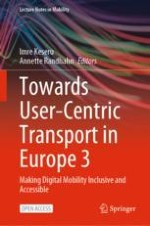This book gathers contributions to the EU-funded Horizon 2020 project INDIMO (Inclusive Digital Mobility Solutions), its sister projects DIGNITY (Digital Transport in and for Society) and TRIPS (Transport Innovation for Persons with Disabilities Needs Satisfaction), which have been focusing on making transport systems inclusive and accessible for all. Digitalization has enabled the emergence and proliferation of novel, ‘disruptive’ transport and delivery services. These services are often exclusively only available through digital channels such as a smartphone app or website. Yet a substantial segment of the population is at risk of being excluded from these services for a variety of reasons. Therefore, it is strongly necessary to integrate inclusivity and accessibility into the design and operation of mobility services. This book aims at discussing cases of and reasons for digital exclusion in transport. It also investigates the role of participatory and user-centric planning and design methods in making digital mobility more inclusive and accessible. Further, it discusses tools and technologies that could help policy makers to develop digital mobility as a more inclusive and accessible service.
This is an open access book.
